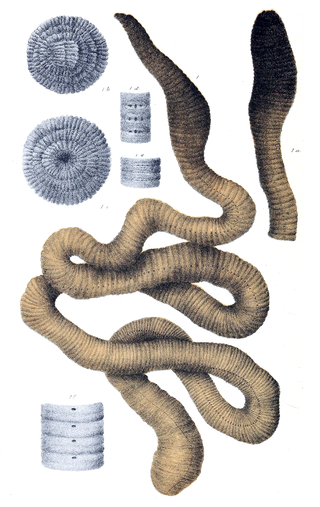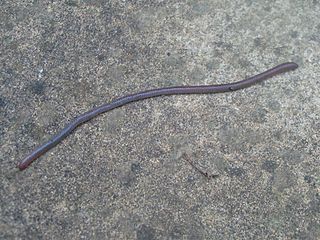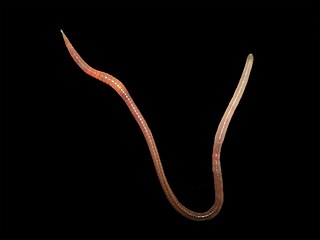
The Lumbricidae are a family of earthworms. About 33 lumbricid species have become naturalized around the world, but the bulk of the species are in the Holarctic region: from Canada and the United States and throughout Eurasia to Japan. An enigmatic species in Tasmania is Eophila eti. Currently, 670 valid species and subspecies in about 42 genera are recognized. This family includes the majority of earthworm species well known to Europeans and Asians

Oligochaeta is a subclass of animals in the phylum Annelida, which is made up of many types of aquatic and terrestrial worms, including all of the various earthworms. Specifically, oligochaetes comprise the terrestrial megadrile earthworms, and freshwater or semiterrestrial microdrile forms, including the tubificids, pot worms and ice worms (Enchytraeidae), blackworms (Lumbriculidae) and several interstitial marine worms.

Megascolecidae is a taxonomic family of earthworms native to Madagascar, Australia, New Zealand, Southeast Asia, and North America. All species of the Megascolecidae belong to the Clitellata class. The Megascolecidae comprise a large family of earthworms and they can grow up to 2 meters in length. The intercontinental distribution of Megascolecidae species favours the continental drift theory.
Sparganophilus, the only genus in the family Sparganophilidae, is a group of long, slender, limicolous (mud-dwelling) earthworms native to North America. The number of species is unknown, most of them are undescribed, throughout the continent and into Central America. One species, S. tamesis, has been introduced into the streams of Europe, where it is now widespread; its synonyms are S. eiseni, S. benhami, S. guatemalensis, S. carnea, S. elongatus, S. cuenoti and, newly, S. langi.

The giant Gippsland earthworm, Megascolides australis, is one of Australia's 1,000 native earthworm species.

The coast mole or Pacific mole is a medium-sized North American mole found in forested and open areas with moist soils along the Pacific coast from southwestern British Columbia to northwestern California.

The Haplotaxida are one of two orders within the annelid subclass Oligochaeta, the other being the Lumbriculida. No real common name exists, but they are simply referred to as haplotaxids.

An earthworm is a soil-dwelling terrestrial invertebrate that belongs to the phylum Annelida. The term is the common name for the largest members of the class Oligochaeta. In classical systems, they were in the order of Opisthopora since the male pores opened posterior to the female pores, although the internal male segments are anterior to the female. Theoretical cladistic studies have placed them in the suborder Lumbricina of the order Haplotaxida, but this may change. Other slang names for earthworms include "dew-worm", "rainworm", "nightcrawler", and "angleworm". Larger terrestrial earthworms are also called megadriles as opposed to the microdriles in the semiaquatic families Tubificidae, Lumbricidae and Enchytraeidae. The megadriles are characterized by a distinct clitellum and a vascular system with true capillaries.
Rhinodrilus fafner is a presumed extinct giant earthworm from the family Glossoscolecidae. It is only known by the ill-preserved holotype discovered in 1912 near Belo Horizonte in the Brazilian state of Minas Gerais and described in 1918 by German zoologist Wilhelm Michaelsen (1860–1937) from the National History Museum in Hamburg. The collected individual has a length of 210 centimetre and the body which consists of 600 single segments is 24 millimetre in diameter. Along with Amynthas mekongianus and Megascolides australis, Rhinodrilus fafner is among the largest known giant earthworms. Rhinodrilus fafner was confined to a small habitat and vanished possibly due to habitat destruction. It was officially declared extinct by the Brazilian Ministry of Environment (MMA) in 2003. However, the rediscoveries of the Giant Palouse earthworm in 2005 and the Brazilian earthworm Fimoscolex sporadochaetus in 2007 created hope that Rhinodrilus fafner may be found again.
Rhinodrilus is a genus of large South American earthworms. It belongs to the family Glossoscolecidae.
Earthworms are invasive species throughout the world. Of a total of about 6,000 species of earthworm, about 120 species are widely distributed around the globe. These are the peregrine or cosmopolitan earthworms. Some of these are invasive species in many regions.

The annelids, also known as the segmented worms, are a large phylum, with over 22,000 extant species including ragworms, earthworms, and leeches. The species exist in and have adapted to various ecologies – some in marine environments as distinct as tidal zones and hydrothermal vents, others in fresh water, and yet others in moist terrestrial environments.
Samuel James is an American scientist, a researcher specializing in evolutionary biology, focusing on earthworm taxonomy. James, with fellow researchers, has discovered numerous species of annelids, including Diplocardia californiana, Diplocardia woodi, Diplocardia montana, and a new species related to the Giant Palouse earthworm.
Glossoscolex is a genus of South American earthworm.
Enantiodrilus is a genus of South American earthworm in the family Glossoscolecidae.

Pontoscolex is a genus of earthworms in the family Glossoscolecidae, or alternatively, in the family Rhinodrilidae.
Andiorrhinus is a genus of earthworm in the family Glossoscolecidae. The genus contains 37 species subdivided into four subgenera.
Opisthopora is an order of mostly terrestrial worms.
Grizelle González is a soil ecologist working for the United States Forest Service in San Juan, Puerto Rico. She is known for her work on soil ecology, nutrient cycling, and ecosystem ecology at the Sabana Field Research Station in Puerto Rico.

Pontoscolex corethrurus is an earthworm in the genus Pontoscolex. It has a circumtropical distribution, although it originates in the Neotropics, probably in the Guiana Plateau.








